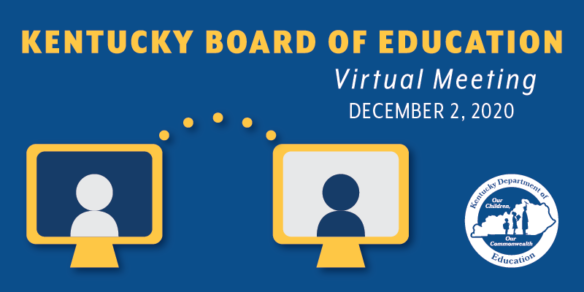
- At the board’s request, the Office of Assessment and Accountability sought feedback from various groups on changes to the accountability system.
- In keeping with its commitment to anti-racism and equity in Kentucky public schools, the KBE approved the items for inclusion in the board’s policy priorities for the next legislative session, which will open in January.
By Jacob Perkins
Jacob.perkins@education.ky.gov
During the Kentucky Board of Education’s (KBE) Dec. 2 regular meeting, the board reviewed recommended changes to the state’s accountability system to align it with Senate Bill (SB) 158 (2020).
Originally planned to be a first read and action item, the board had shifted its agenda after the Dec. 1 special meeting of the Local Superintendents Advisory Council (LSAC), where members felt modifying the system was an item that deserved more time and opportunities to gather input.
To speed up the process on noncontroversial and/or technical changes to regulatory items, the KBE now will act after a first read. However, for matters that are more complex or substantive in nature, the board may choose to have a second reading to allow for more deliberation.
SB 158 amends KRS 158.6455 to create an accountability system that includes an annual differentiation of all public schools in the state using multiple measures that describe each district’s overall performance, school and student demographic group.
SB 158 also requires districts to be evaluated on “status” and “change” for state indicators, which include student assessment results, progress toward achieving English proficiency by English learners, quality of school climate and safety, high school graduation rates and postsecondary readiness.
For each indicator, there are five status levels ranging from very high to very low and five change levels, ranging from increased significantly to decreased significantly.
Staff from the Kentucky Department of Education (KDE) have developed a 5 x 5 color-coded table that combines both status and change. The colors represented on the table are – ranking from low to high – red, orange, yellow, green and blue.
“The intent of the language in the statute is to generate this 5 x 5,” explained Rhonda Sims, associate commissioner in KDE’s Office of Assessment and Accountability (OAA). “Each one of the state indicators would have one of these color charts so you get a broad sense of what is occurring at the school.”
At the board’s request, OAA sought feedback from various groups on changes to the accountability system. The groups agreed there should be fewer yellow – or mid-level – designations on the color-coded table. This would allow schools to better see change – good or bad – and reduce the likelihood of schools becoming stagnant.
Based on discussions during the KBE’s Nov. 6 special meeting, OAA recommended also using colors to designate an overall performance rating for elementary, middle and high schools. This color system would replace the current star-rating system that was used to communicate school performance.
In the new system, red would represent the lowest rating and blue would represent the highest. Color ratings would have five performance levels including, from highest to lowest, blue, green, yellow, orange and red.
Additionally, the board heard about the department’s recommendation to set the minimum number of students needed to form a student subgroup for accountability to 30, while still counting 10 students per grade for public reporting.
The performance of student groups included in accountability and public reporting currently is set at 10 or more per grade. This standard helps protect student privacy by making it harder to identify the scores of individual students. Kentucky has historically used a minimum of 10 students per grade, which applies to schools and student groups.
Asked about the feedback OAA has received on the minimum number of students needed to form subgroups, Jennifer Stafford, director of KDE’s Division of Assessment and Accountability Support, said one suggestion has been to continue counting 10 students per grade, while also adding the 30 per school.
“That’s another direction that the board could discuss and decide upon as well,” Stafford said, adding that OAA is unsure if this would be allowed at the federal level.
The recommended changes to the accountability system will appear before the board again for a second read and action at its regular meeting in February.
Assessments
At the August KBE meeting, board members had expressed interest in improving and rethinking the assessments reported in the state assessment results indicator of the accountability system.
Staff in OAA introduced a “Triple Track” approach at the October board meeting that would allow for immediate changes to occur on the accountability regulation to align with SB 158, build a foundational process for improved assessment design and create a transformational assessment system that better supports instruction and grows Kentucky learners.
Building on these conversations, OAA staff introduced a discussion on the state’s assessment system during the virtual meeting.
After a presentation highlighting federal and state assessment requirements, OAA informed the board that current guidance from the U.S. Department of Education is for states to plan on assessing students in the spring of 2021.
“We just don’t know what the spring is going to look like,” said Jason E. Glass, commissioner of education. “I think our best strategy right now is to go ahead and take steps to be prepared for a spring administration in some form.”
KDE has looked at how to scale back the assessment due to the ongoing COVID-19 pandemic and its impacts on learning, Sims said.
“Frankly, we think this is the right thing to do for our Kentucky schools,” she said.
With a new secretary of education expected at the national level and a potential change in directive to cancel spring assessments, Sims said the department will continue to work toward the future of assessment in the Commonwealth, regardless of the spring decision.
Beginning in mid-December, OAA will work to explore innovative, performance-based assessments, with partnership from The Center for Innovation in Education, The Center for Assessment, and KDE’s Division of Innovation and Districts of Innovation.
Commissioner’s Report
Along with providing the board with updates on the Kentucky School for the Blind (KSB), the Kentucky School for the Deaf (KSD) and Kentucky’s Area Technology Centers, Glass discussed Gov. Andy Beshear’s executive order to suspend in-person classes beginning Nov. 23 during his report to the KBE.
The order requires all middle and high schools (grades 6-12) to implement nontraditional instruction and not resume in-person learning before Jan. 4.
Elementary schools (grades K-5) are allowed to reopen for in-person instruction beginning Dec. 7, as long as the school is not in a red zone county and follows all the safety expectations found in the Healthy at School guidance document.
Though the order suspends in-person instruction, it does not prohibit schools from providing in-person targeted services to small groups, Glass said.
On Aug. 17, KDE issued guidance that details appropriate measures districts should follow when bringing small groups of students into the building for short orientation periods or to provide targeted services. The document presents universal expectations and considerations for targeted services and special populations.
With COVID-19 cases continuing to rise across the Commonwealth, districts should know what options are available for employee leave. On July 21, KDE released guidance designed to provide an overview of leave options for school district personnel for the 2020-2021 school year.
This guidance was provided to school districts to help answer questions surrounding leave options. Since it is not legal advice, districts should consult their board counsel when making individual personnel decisions.
Following the commissioner’s report, KBE Vice Chair Sharon Porter Robinson asked Glass if there is a way the department could determine the social/emotional impact school building closures have had on Kentucky’s students. She said this data could be useful for preparing educators and school staff for a return to in-person instruction.
Though KDE currently does not have a method in place to gather this data, Glass said the department will utilize the Commissioner’s Student Advisory Council as one way to collect this information.
“Our student advisory council is a large and very engaged and active group,” he said. “We can talk to them about what they are experiencing and what would be supports for them on the other side of this.”
KBE Policy Priorities
In keeping with its commitment to anti-racism and equity in Kentucky public schools, the KBE approved its budget and policy priorities for the next legislative session, which will open in January.
These priorities are tied to the board and department’s strategic goals, and a primary focus will be on maintaining, restoring and obtaining additional needed funding for key programs and services.
This includes securing sufficient funding for general operations and maintenance of campus facilities at KSB and KSD, restoring funding for the initiatives in the Kentucky Academy for Equity in Teaching, restoring School Improvement Funds and funding for instructional resources, and gaining additional funding for the Support Education Excellence in Kentucky (SEEK) Transportation fund.
During the 2020 regular session, Senate Bill 177 set forth alternate provisions for local school districts to use when calculating their average daily attendance (ADA) used in the SEEK fund determinations for the 2019-2020 school year. The provisions agreed upon and provided by SB 177 prevented the loss of substantial state funding traditionally based on ADA. This permitted districts to use a variety of instructional delivery models in response to COVID-19 based on attendance and participation through virtual or hybrid instructional delivery models.
However, the provisions as defined by SB 177 only applied to the 2019-2020 school year. The board’s priority is to obtain legislative relief and apply the intended supports within SB 177 to the 2020-2021 and 2021-2022 school years.
Obtaining this relief will allow the state’s funding provisions to accommodate in-person, virtual and hybrid instructional delivery models as the COVID-19 emergency continues.
“We think these priorities are important and they are reasonable for us to lift up in what is going to be a short (legislative) session,” Glass said.
Jefferson County Management Audit
Based on the findings of the management audit of Jefferson County Public Schools (JCPS), Glass said all requirements of the August 2018 settlement agreement between the state and district have been met and did not feel it was necessary to recommend state management or assistance to the KBE.
He recommended the district should review the recommendations of the audit in detail and incorporate the recommendations into weekly cabinet meetings and the JCPS District Improvement Plan.
Glass said the settlement agreement should be considered fulfilled and JCPS released from further implementation of the formal corrective action plan implemented pursuant to the agreement.
“This is a good outcome,” said KBE Chair Lu Young. “It’s not a perfect outcome. Districts aren’t perfect places and there is a lot of work ahead.”
On Sept. 21, a KDE-appointed audit team initiated the management audit of JCPS, pursuant to the settlement agreement and KRS 158.785.
Between Sept. 21 and Oct. 9, the KDE management audit team virtually conducted 1,588 interviews with various JCPS stakeholders, including members of the school board, members of school-based decision making councils, district and school administrators, and certified and classified staff. The team reviewed district data, documents and the corrective action plan throughout the process.
In other business, the board:
- Adopted a resolution recognizing KBE Executive Director Jennifer Fraker. The Dec. 2 meeting was Fraker’s final meeting with the department before she begins her new role with the Kentucky Council on Postsecondary Education (CPE);
- Adopted a resolution to establish the Commonwealth Education Continuum;
- Approved the KBE Kevin C. Brown Strategic Priority Award recipient. The award will be presented at the board’s regular meeting in February;
- Heard reports from CPE Associate Vice President Amanda Ellis, Kentucky High School Athletic Association (KHSAA) Commissioner Julian Tackett and Lt. Gov. and Education and Workforce Development Cabinet Secretary Jacqueline Coleman, who serves as an ex officio KBE member;
- Approved consent agenda items:
-
- New District Facility Plans for the Anderson County, Bellevue Independent, Caldwell County, Carter County, Marshall County, Pike County and Raceland-Worthington Independent School Districts;
- District Facility Plan Amendments for the Hardin and Scott County School Districts;
- 2020-2021 Local District Tax Rates Levied;
- Amendment to 702 KAR 5:080, Bus Drivers’ Qualifications;
- 2019 Carl D. Perkins Consolidated Annual Report;
- Waiver of KY Tech Policy 08.5- Flagging Programs and Student/Teacher Ratios;
- Amendment to 703 KAR 5:280, School Improvement Procedures;
- Application of waiver of administrative regulations from the Kenton County School District;
- Accepted a report on Title IX Deficiencies from Tackett, KHSAA General Counsel Chad Collins and KDE General Counsel Todd G. Allen;
- Accepted a KDE employment report from KDE Associate Commissioner Robin Kinney and Lynn McGowan-McNear, director of KDE’s Division of Resource Management;
- Recognized the recipients of the 2019-2020 Presidential Award for Excellence in Mathematics and Science Teaching;
- Presented the 2020 Kevin N. Noland-Mary Ann Miller Award to KDE Associate Commissioner Gretta Hylton;
- Approved 2020-2021 Local District Working Budgets and instructed KDE to request the Ashland Independent school district, which has not submitted a working budget, provide the department with a report of the financial position of the district within 30 days;
- Approved 704 KAR 8:110, Kentucky Academic Standards for World Language, which contains the minimum required academic content for any world language course or program offered in Kentucky’s public schools;
- Heard an update on the status of the most recent audit activities in KDE and local school districts;
- Approved Glass’ proposed 2020-2021 goals and agreed the goals will be used as part of his 2021 performance evaluation; and
- Established its vision statement, mission statement and goals.




Leave A Comment